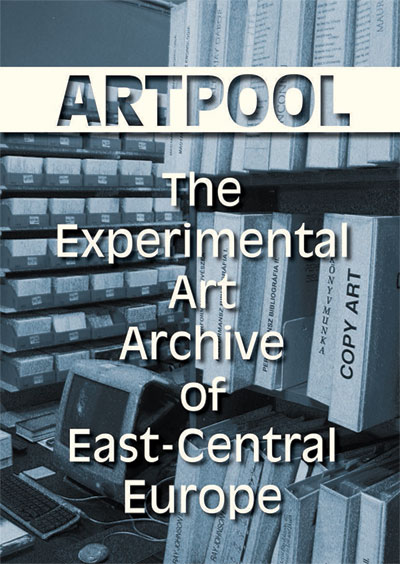György Galántai, Julia Klaniczay (eds.): Artpool: The Experimental Art Archive of East-Central Europe (2013)
Filed under book | Tags: · archive, art, art history, artists book, avant-garde, east-central europe, fluxus, mail art, performance, sound poetry, visual poetry

“How could an arts initiative, called Artpool, in the 1970s, in a small corner of the world, in East-Central Europe, become a significant node, a reference point in a worldwide – initially analogue (postal) then digital (online) – network?
How has it been able to validly speak out and address issues and people again and again in the ‘storms’ of history and scientific-technological progress, for more than four decades now?
Using authentic documents, numerous photographs and illustrations Artpool’s chronological volume containing a brief presentation of events and exhibitions, a detailed bibliography and references follows the history of the Artpool art project – launched more than forty years ago by fine artist György Galántai and later jointly realized with Júlia Klaniczay – from the exhibitions of the Chapel Studio active in Balatonboglár between 1970 and 1973, through the establishment of the Artpool archive in 1979 to the opening of the Artpool Art Research Center in Budapest in 1992 and its becoming an esteemed research facility by the 2010s.
Hundreds of artists from all corners of the world sent their works to the international Artpool exhibitions, which are built on the “Active Archive” concept and explore themes inspired by our perpetually changing world, in the same way as György Galántai and Artpool also participated in the events organized in the various other nodes of the “Eternal Network”.
The information accumulated in Artpool over the forty years, the collections that were built up, and the research work based on them form the tissue of today’s institute, which beyond the developments in the art scene also informs us about the eventful forty or so years during which Artpool came into being and has continued to operate. This period can be best described by the following keywords: communism, iron curtain, secret files, tapping telephone wires, bans, “the happiest barrack”, samizdat publications, counterculture, change of the system, democratic transition, freedom of the press and speech, independent non-profit initiatives, European Union, strengthening nationalism and conservatism; 20th century, millennium, 21st century; technological and communication explosion.”
Foreword by Kristine Stiles
Publisher Artpool, Budapest, 2013
ISBN 9630872250, 9789630872256
535 pages
PDF (50 MB, updated on 2019-10-29)
Flash
thresholds, 41: Revolution! (2013)
Filed under journal | Tags: · activism, architecture, archive, city, media, memory, politics, protest, public space, revolution, urbanism

“What actions are prompted by revolution in the space of the city? Which publics take part in this struggle, and who are the agents that mobilize it? And after a revolution has subsided, how is it remembered, represented and memorialized? thresholds 41: REVOLUTION! turns to the history, design, and cultural production of the public realm as a site of dissensus. Rather than focusing on a specific revolutionary time and place, we have strived to include different periods and regions, organizing contributions in terms of the relations they establish between sites, actors, and contexts. In the essays and designs featured in these pages, political struggle often shifts established roles—agitators create new types of public space, designers become activists and fundraisers, individual figures fade in favor of collectives or groups, and actions are best remembered through misrepresentation. How do we write revolution, who writes it and for whom? And, in turn, how does urban conflict inform writing, design, and cultural production at large? Our authors, designers, and artists open up revolution as subject, as event, and as historiographical problem—a problem complicated by discrete actions, multiple publics, critical practices, and the politics of display and remembrance.”
Contributors: David Gissen, Robin Adèle Greeley, Britt Eversole, Arindam Dutta, Diane E. Davis and Prassana Raman, Mark Jarzombek, Thérèse F. Tierney, Kenneth Ip, Nasser Rabbat, Reinhold Martin, Tunney Lee and Lawrence Vale, Andrés Jaque Architects + Office for Political Innovation, Santiago Cirugeda + Recetas Urbanas, Nomeda Urbonas and Gediminas Urbonas, The Yes Men, Ateya Khorakiwala, Simone Brott, Andrés Estefane, Kelly Presutti, Mechtild Widrich, Montenegro Airways
Edited by Ana María León
Publisher SA+P Press / MIT Department of Architecture, Cambridge, MA, Spring 2013
Open Access
ISSN 1091-711X
ISBN 9780983508267
212 pages
PDF (13 MB)
Comment (0)Scott MacKenzie (ed.): Film Manifestos and Global Cinema Cultures: A Critical Anthology (2014)
Filed under book | Tags: · aesthetics, archive, avant-garde, cinema, colonialism, decolonization, documentary film, feminism, film, film history, gender, manifesto, museum, pornography, postcolonialism, queer, sexuality

“This is the first book to collect manifestos from the global history of cinema, providing the first historical and theoretical account of the role played by film manifestos in filmmaking and film culture. Focusing equally on political and aesthetic manifestos, Scott MacKenzie uncovers a neglected, yet nevertheless central history of the cinema, exploring a series of documents that postulate ways in which to re-imagine the cinema and, in the process, re-imagine the world.
This volume collects the major European “waves” and figures (Eisenstein, Truffaut, Bergman, Free Cinema, Oberhausen, Dogme ‘95); Latin American Third Cinemas (Birri, Sanjinés, Espinosa, Solanas); radical art and the avant-garde (Buñuel, Brakhage, Deren, Mekas, Ono, Sanborn); and world cinemas (Iimura, Makhmalbaf, Sembene, Sen). It also contains previously untranslated manifestos co-written by figures including Bollaín, Debord, Hermosillo, Isou, Kieslowski, Painlevé, Straub, and many others. Thematic sections address documentary cinema, aesthetics, feminist and queer film cultures, pornography, film archives, Hollywood, and film and digital media. Also included are texts traditionally left out of the film manifestos canon, such as the Motion Picture Production Code and Pius XI’s Vigilanti Cura, which nevertheless played a central role in film culture.”
Publisher University of California Press, 2014
ISBN 0520276744, 9780520276741
xxi+651 pages
via slowrotation
Author’s talk (video, 2017, 20 min).
Reviews: Wheeler Winston Dixon (Film International), Matthew Hunt, Bill Nichols (Film Quarterly).
PDF, PDF (updated on 2019-7-14)
Comment (0)
